Related Research Articles
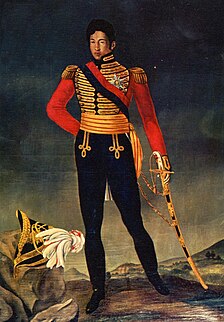
Radama I "the Great" (1793–1828) was the first Malagasy sovereign to be recognized as King of Madagascar (1810–1828) by a European state. He came to power at the age of 18 following the death of his father, King Andrianampoinimerina. Under Radama's rule and at his invitation, the first Europeans entered his central highland Kingdom of Imerina and its capital at Antananarivo. Radama encouraged these London Missionary Society envoys to establish schools to teach tradecraft and literacy to nobles and potential military and civil service recruits; they also introduced Christianity and taught literacy using the translated Bible. A wide range of political and social reforms were enacted under his rule, including an end to the international slave trade, which had historically been a key source of wealth and armaments for the Merina monarchy. Through aggressive military campaigns he successfully united two-thirds of the island under his rule. Abuse of alcohol weakened his health and he died prematurely at age 35. He was succeeded by his highest-ranking wife, Ranavalona I.
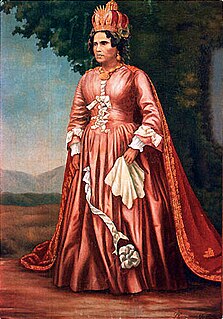
Ranavalona I, also known as Ranavalo-Manjaka I, was sovereign of the Kingdom of Madagascar from 1828 to 1861. After positioning herself as queen following the death of her young husband, Radama I, Ranavalona pursued a policy of isolationism and self-sufficiency, reducing economic and political ties with European powers, repelling a French attack on the coastal town of Foulpointe, and taking vigorous measures to eradicate the small but growing Malagasy Christian movement initiated under Radama I by members of the London Missionary Society. She made heavy use of the traditional practice of fanompoana to complete public works projects and develop a standing army of between 20,000 and 30,000 Merina soldiers, whom she deployed to pacify outlying regions of the island and further expand the realm. The combination of regular warfare, disease, difficult forced labor and harsh trials by ordeal using a poisonous nut from the Tangena shrub resulted in a high mortality rate among both soldiers and civilians during her 33-year reign, with Madagascar's population reducing from 5 million in 1833 to 2.5 million in 1839.
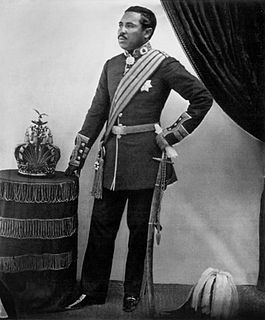
Radama II was the son and heir of Queen Ranavalona I and ruled from 1861 to 1863 over the Kingdom of Madagascar, which controlled virtually the entire island. Radama's rule, although brief, was a pivotal period in the history of the Kingdom of Madagascar. Under the unyielding and often harsh 33-year rule of his mother, Queen Ranavalona I, Madagascar had successfully preserved its cultural and political independence from European colonial designs. Rejecting the queen's policy of isolationism and persecution of Christians, Radama II permitted religious freedom and re-opened Madagascar to European influence. Under the terms of the Lambert Charter, which Radama secretly contracted in 1855 with French entrepreneur Joseph-François Lambert while Ranavalona still ruled, the French were awarded exclusive rights to the exploitation of large tracts of valuable land and other lucrative resources and projects. This agreement, which was later revoked by Prime Minister Rainilaiarivony, was key to establishing France's claim over Madagascar as a protectorate and, in 1896, as a colony.
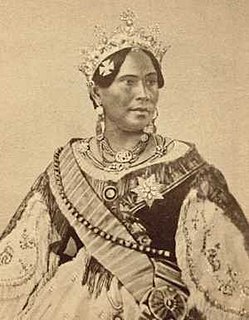
Rasoherina was Queen of Madagascar from 1863 to 1868, succeeding her husband Radama II following his presumed assassination.

The Merina people are the largest ethnic group in Madagascar. They are the "highlander" Malagasy ethnic group of the African island and one of the country's eighteen official ethnic groups. Their origins are mixed, predominantly with Malayo-Indonesians arriving before the 5th century AD, then many centuries later by Arabs, Africans and other ethnic groups. They speak the Merina dialect of the official Malagasy language of Madagascar.

Menabe is a region in western Madagascar, with its capital at Morondava. It covers an area of 46,121 square kilometres, and its population was 700,577 in 2018. The population mostly belongs to the Sakalava ethnic group. The region is named after the 18th-century Sakalava Kingdom of Menabe. The name "Menabe", in turn, means "big red", after the color of laterite rock that dominates the landscape.

Rainilaiarivony was a Malagasy politician who served as the Prime Minister of Madagascar from 1864 to 1895, succeeding his older brother Rainivoninahitriniony, who had held the post for thirteen years. His career mirrored that of his father Rainiharo, a renowned military man who became Prime Minister during the reign of Queen Ranavalona I.

The Franco-Hova Wars, also known as the Franco-Malagasy Wars were two French military interventions in Madagascar between 1883 and 1896 that overthrew the ruling monarchy of the Merina Kingdom, and resulted in Madagascar becoming a French colony. The term "Hova" referred to a social class within the Merina class structure.

The Rovä of Antananarivo is a royal palace complex (rova) in Madagascar that served as the home of the sovereigns of the Kingdom of Imerina in the 17th and 18th centuries, as well as of the rulers of the Kingdom of Madagascar in the 19th century. Its counterpart is the nearby fortified village of Ambohimanga, which served as the spiritual seat of the kingdom in contrast to the political significance of the Rova in the capital. Located in the central highland city of Antananarivo, the Rova occupies the highest point on Analamanga, formerly the highest of Antananarivo's many hills. Merina king Andrianjaka, who ruled Imerina from around 1610 until 1630, is believed to have captured Analamanga from a Vazimba king around 1610 or 1625 and erected the site's first fortified royal structure. Successive Merina kings continued to rule from the site until the fall of the monarchy in 1896, frequently restoring, modifying or adding royal structures within the compound to suit their needs.

Rainivoninahitriniony (1824–1868), was Prime Minister of the Kingdom of Madagascar between 1852 and 1864. He was the chief engineer of the Aristocratic Revolution initialized upon the attempted assassination of King Radama II. His excesses and participation in the regicide saw him fall from favor, ultimately being relieved of his position and replaced as Prime Minister by his younger brother Rainilaiarivony. Rainivoninahitriniony died in exile on May 5, 1868, shortly after an attempted coup meant to enable him to regain his position upon the death of Queen Rasoherina ended in failure.
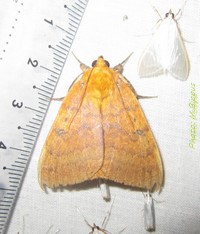
Achaea is a genus of moths in the family Erebidae described by Jacob Hübner in 1923.

Ugia is a genus of moths in the family Erebidae erected by Francis Walker in 1858.
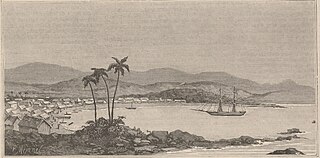
The First Madagascar expedition was the beginning of the Franco-Hova War and consisted of a French military expedition against the Merina Kingdom on the island of Madagascar in 1883. It was followed by the Second Madagascar expedition in 1895.

Tangena is the indigenous name for the tree species Cerbera manghas of Madagascar, which produces highly toxic nuts that were historically used on the island for trials by ordeal to determine the guilt or innocence of an accused party.

Achaea radama is a species of moth of the family Erebidae. It is found in Madagascar.

Epipyrops is a genus of moths in the family Epipyropidae. Also known as Fulgoraecia.

Agrapha orbifer is a moth of the family Noctuidae. It is found on La Réunion.

Christianity in Madagascar is practiced by 41% of Madagascans, according to the U.S. Department of State in 2011, or by 85% of them according to the Pew Research Center in 2010, often in syncretic form with traditional religious practices. Protestantism was introduced by the first envoys of the London Missionary Society in 1818, who proselytized and taught literacy through a Malagasy language Bible at the public schools they established in the highlands at the request of King Radama I. The number of converts remained low but gradually grew under repression during the reign of his successor, Queen Ranavalona I, and the more permissive religious policies of her son, Radama II, and his widow, Queen Rasoherina.
Ugia radama is a species of moth in the family Erebidae. It is found in Madagascar.

Princess Raketaka was heir to the throne of Madagascar until her father Radama I died. She was also the mother of the last queen, Ranavalona III.
References
- ↑ Beccaloni, G.; Scoble, M.; Kitching, I.; Simonsen, T.; Robinson, G.; Pitkin, B.; Hine, A.; Lyal, C., eds. (2003). "Fulgoraecia radama". The Global Lepidoptera Names Index . Natural History Museum . Retrieved May 23, 2018. Note: This source gives 1960 as the year of description.
- ↑ Afro Moths
| This article relating to the superfamily Zygaenoidea is a stub. You can help Wikipedia by expanding it. |